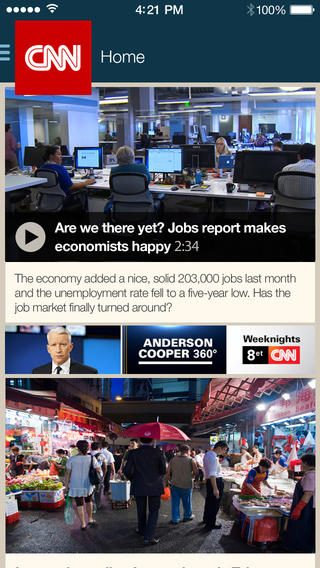
This will be the year CNN sees the majority of its online audience come from mobile devices.
 There’s a level of inevitability to that stat that almost seems boring at this point. The company recently announced that in 2013, 40 percent of the traffic to CNN.com came from mobile, so 50 percent isn’t some distant goal.
There’s a level of inevitability to that stat that almost seems boring at this point. The company recently announced that in 2013, 40 percent of the traffic to CNN.com came from mobile, so 50 percent isn’t some distant goal.
“We probably could turn off the lights and go home and it would happen sooner or later anyway. But we need to push it,” said Meredith Artley, managing editor of CNN Digital.
That’s not a brag — just the reality of more consumers getting mobile devices in their hands and spending more time with them. As people continue to spend more time with their phones — Pew Research says 63 percent of U.S. adult mobile owners use their phone to go online — all media companies are seeing a lift in their mobile stats. ESPN’s mobile audience surpassed desktop readers in late 2013; traffic to the BBC’s website is majority mobile on weekends. (Major technology companies long ago passed that barrier — 48 percent of Facebook’s active users are now only using mobile over a given month.)
Instead of standing pat, in 2014 CNN wants to capitalize on their mobile audience by finding more effective ways to deliver breaking news, delivering better video over mobile, and syncing up the experiences of social media and mobile. Artley said CNN was like many news organizations that once only saw mobile as place they had to be, turf to be covered. But what changed was the realization that delivering news on devices deserved equal consideration as delivering it on your laptop. “We as a team realized mobile is not downstream from desktop,” she said. Now, when the company talks about mobile, it’s including smartphone web browsers as well as apps, and often the connection between social media and mobile content consumption.
 Part of planning for 2014 means analyzing how CNN users spent their time in 2013. Last year, CNN’s network of sites had 67 million unique visitors per month and averaged 1.9 billion monthly pageviews. CNN’s traffic mirrors much of the industry, rising and falling with the hours of the workday, with surges in desktop traffic between noon and 1 p.m. An evening decline in desktop is typically replaced by a surge in mobile, with 8:00 to 11:00 p.m. when the audience is most active, said Etan Horowitz, CNN’s mobile editor. “The later in the day that a breaking news story happens, the more likely it will be bigger on mobile than desktop,” Horowitz said.
Part of planning for 2014 means analyzing how CNN users spent their time in 2013. Last year, CNN’s network of sites had 67 million unique visitors per month and averaged 1.9 billion monthly pageviews. CNN’s traffic mirrors much of the industry, rising and falling with the hours of the workday, with surges in desktop traffic between noon and 1 p.m. An evening decline in desktop is typically replaced by a surge in mobile, with 8:00 to 11:00 p.m. when the audience is most active, said Etan Horowitz, CNN’s mobile editor. “The later in the day that a breaking news story happens, the more likely it will be bigger on mobile than desktop,” Horowitz said.
Editors saw proof of this repeatedly in 2013, including the initial stories on the government shutdown, which began late at night. Similarly, Horowitz said that weekend traffic for CNN.com is nearing majority-mobile status. The day actor Paul Walker died in a car crash in November, mobile pageviews far exceeded the desktop, Horowitz said.
“The behavior on the mobile website is people checking in and saying: ‘Hey, did the world blow up?'” he said.
Artley said programming for mobile is part of the daily editorial meetings for CNN’s digital staff. The company’s CMS makes it possible to program the mobile site differently than desktop. With that, CNN is able to be responsive to how that audience reads and what they’re looking for in different situations. Horowitz said they’ll give weather stories and information primacy on mobile, as well as travel updates and airline information.
At CNN, planning for mobile also works in concert with social media strategy. Social media can be a strong driver of mobile traffic thanks to all the time that people spend with Twitter and Facebook on their phone, said Lila King, senior director of social news for CNN.
King said CNN’s mobile and social teams spend a fair amount of time looking at numbers to get a better understanding of what works. While Facebook drives more traffic than Twitter to CNN on desktop, on mobile the numbers are more even, she said. King said one area they want to improve in 2014 is connecting people to video through social channels.
“It’s about looking at data and detecting the patterns, and the patterns tend to start with mobile,” King said.
Horowitz told me the future on mobile is differentiation — specifically between apps and what’s possible within mobile web browsers. CNN currently works in both, but the app allows users to watch live video. As a result of that, more users go to the CNN app during live news events or breaking news to watch what’s happening, Horowitz said.
“That gives us an opportunity to rethink the apps and think of them as solving problems and going beyond ‘We give you 10 news stories or 30 news stories,'” he said.
This year, Artley expects CNN will be devoting more resources to mobile, including new hires on Horowitz’s team. They’re also planning to launch a new responsive site later in the year, she said.
Preparing for a mostly-mobile audience is part of the journalism business now, Artley said. But as the number of consumer devices continues to grow, and channels for news discovery expand, Artley said media companies need to ground any strategy in what’s best for users.
“A lot of people talk about ‘mobile first,'” she said. “Who are we to say what screen is first? That’s up to people. Whatever screen you are closest to, CNN is going to be on.”
Image by Hans G. Backman used under a Creative Commons license.